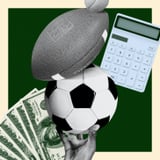As we witness women’s sports breaking records left and right, money has remained at the center of the conversation. People want to know what pay equity in sports really looks like. But in addition to debates about revenue shares and sponsorship dollars, there’s another factor that must be considered: financial literacy.
Right now, there’s more money available to young women athletes than ever before. Thanks to policy changes made in 2021, Name, Image, and Likeness (NIL) opportunities now allow NCAA players to monetize their personal brands while maintaining their amateur status. This might look like the Nike endorsement Caitlin Clark scored while playing for Iowa, or Angel Reese’s deals with Reebok, Coach, and Amazon while at LSU.
But when it comes to managing their personal finances, many athletes are left in the dark. And are we really setting our athletes up for long-term success if they don’t even know how to do their taxes? Here’s what a sports entrepreneur wants you to know about the lack of financial support in women’s sports – and what needs to change going forward.
Experts Featured in This Article:
Danny Cortenraede, is a sports entrepreneur and founder of InStudio Ventures – a venture firm with a focus on emerging sports, technology, and media companies.
Sydney Carter is the Director of Player Development for the University of Texas Women’s Basketball team.
What Athletes Should Know About Money
First, athletes – especially women athletes, who are making lower salaries than men at baseline, even at professional levels – need guidance on how to make money. NIL opportunities can allow players to start earning money, but taking advantage requires real work and know-how.
“Effective leveraging of NIL requires guidance in branding, marketing, and financial management – areas where mentorship and professional advice are crucial,” says sports entrepreneur Danny Cortenraede. For example, because NIL deals are one of the main ways in which young women athletes make their money, marketing is huge. One increasingly important facet of financial security is social media, which has a powerful impact on players’ NIL opportunities.
“As a college athlete, managing your social media might not seem like a huge priority, but these days, personal branding is crucial,” Cortenraede says. “A strong social media presence significantly influences the deals you will attract, making it an essential aspect of maximizing NIL opportunities.” Investing is another consideration, which can be difficult, and even risky, to navigate without any prior education or experience.
If all this sounds unrelated to athletes’ main jobs, consider the fact that in 2009, Sports Illustrated estimated that 78 percent of former NFL players are bankrupt or under financial stress within two years of their retirement, and 60 percent of former NBA players are broke within five years of retirement. These are players who made millions over the course of their careers. But considering how short-term and unpredictable their playing careers can be, money know-how is essential for athletes.
In addition to learning how to leverage all the money-making opportunities at their disposal, athletes need guidance when it comes to how to manage their finances – down to how to pay taxes. This need for financial guidance is something Sydney Carter has personally witnessed as the Director of Player Development for the University of Texas Women’s Basketball team.
“There was a workshop on campus that talked about students filing their taxes because of how much money they were making, and none of my athletes wanted to go,” Carter said in a discussion hosted by Marriott Bonvoy at the Women’s Final Four. In the end, she decided to make the workshop mandatory for all her players so that their taxes would be done correctly. “As soon as I said it, [the athletes] were like, ‘Why do I have to do that?'” Carter remembered. “I wish [the schools] would educate them more on the responsibilities of incoming money, because they just don’t know.”
Who Is Teaching Athletes About Money?
There are currently several different programs for financial education and mentorship, which Cortenraede says is important for inspiration and practical advice. These include the Financial Education Playbook for Athletes, the Players’ Tribune for brand development, and the Professional Athlete Foundation (PAF) for financial planning. “Still, there is ample room to grow and expand these resources to better meet the specific needs of female athletes,” Cortenraede says – from helping players close deals, to guiding them through various aspects of entrepreneurship.
Ultimately, financial literacy is an integral part of athletic development, giving athletes the tools they need to succeed both on and off the court. According to Cortenraede, workshops, mentorships, and increased guidance for branding and marketing are all good steps towards helping young female athletes establish long-lasting careers. “Athletes have the right mindset to perform at the highest level,” he says. “They need a coach and guidance in the financial and investment world.”
Chandler Plante is an assistant editor for POPSUGAR Health & Fitness. Previously, she worked as an editorial assistant for People magazine and contributed to Ladygunn, Millie, and Bustle Digital Group. In her free time, she overshares on the internet, creating content about chronic illness, beauty, and disability.




